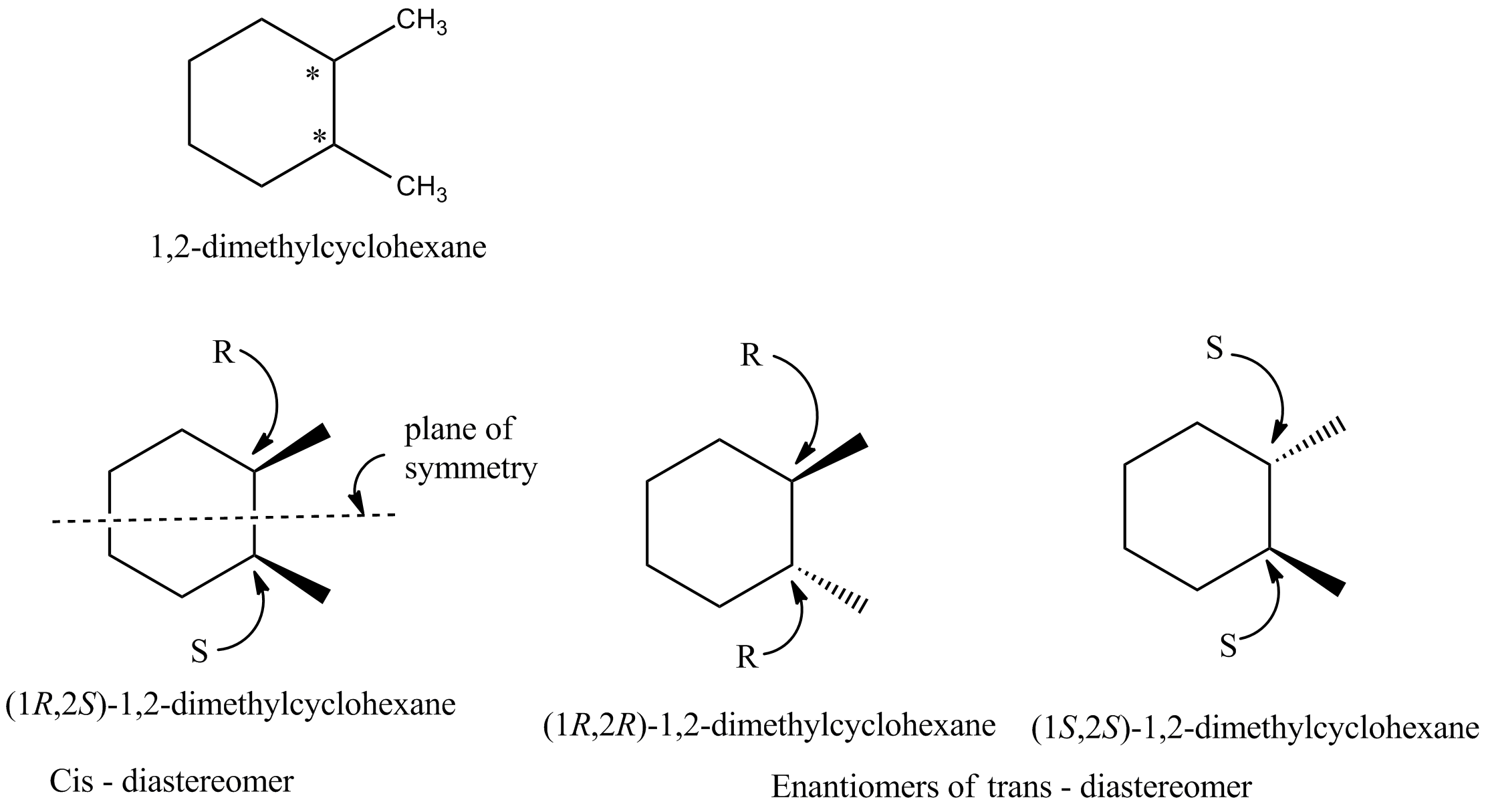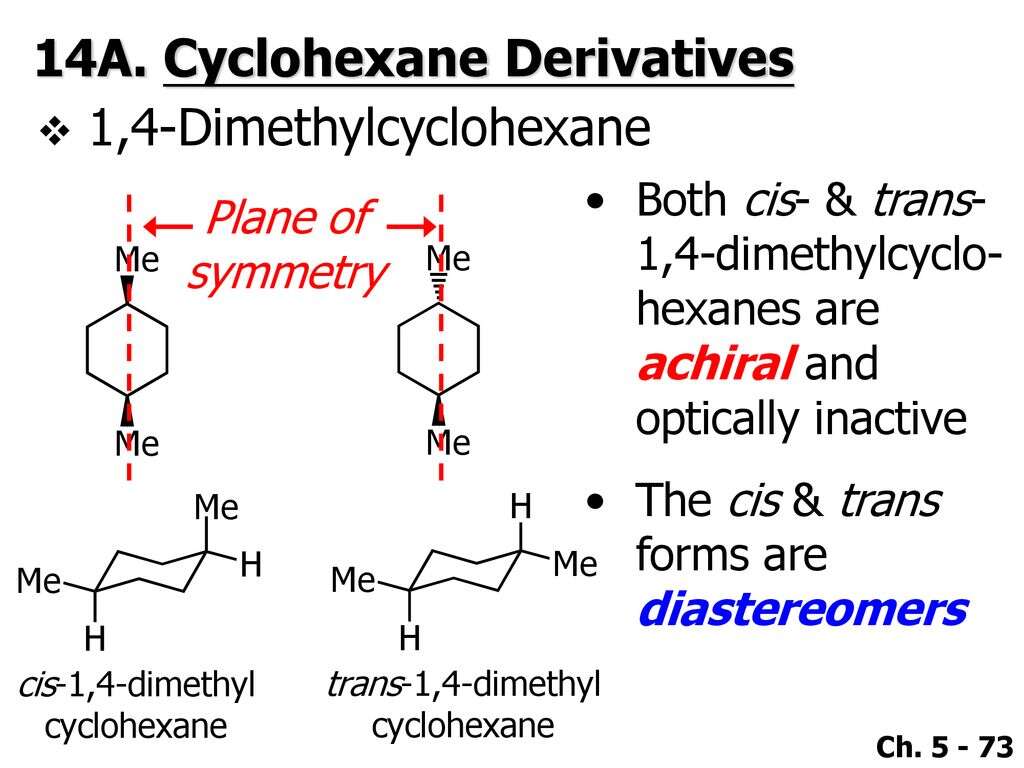Home >
Community >
How can a compound having a plane of symmetry be Chiral?
Upvote
VOTE
Downvote
+ Chirality
+ Stereochemistry
+ Chemistry
Posted by
Mickey Curran
How can a compound having a plane of symmetry be Chiral?
I think you are getting confused between chirality and E-Z isomerism in cyclic structures. So let's clear that up first.
According to IUPAC:
chirality
The geometric property of a rigid object (or spatial arrangement of points or atoms) of being non-superposable on its mirror image; such an object has no symmetry elements of the second kind (a mirror plane, σ = S1, a centre of inversion, i = S2, a rotation-reflection axis, S2n). If the object is superposable on its mirror image the object is described as being achiral.
Chiral molecules are always dissymmetric (lacking $S_n$) but not always asymmetric (lacking all symmetry elements except the trivial identity). However, asymmetric molecules are necessarily always chiral.
For a basic E-Z isomerism definition:
A cycloalkane has two distinct faces, and any substituent on a ring lies toward one of two faces. When two substituents on a ring point to the same face, they are cis. When the two substituents point to opposite faces, they are trans.
Now, I'll address your second question first:
[OP]How is the compound as a whole a Chiral compound because afaik Compounds having a plane of symmetry(Which passes through the two chiral centers in this compound) are supposed to be achiral.
You're right. This compound does possess a plane of symmetry. However, that only means it can't form enantiomers. It can very well form diastereomers (in this case a pair of E-Z isomerism).
Some further examples to illustrate the point:
The trans isomer is achiral, meaning this structure doesn't have enantiomers. However, it still has a cis diastereomer which can show chirality.
An example closer home:
Image courtesy
I'm sure you must've figured out by now, that the carbon on top isn't a capable of showing optical isomerism. However, due to the dissimilar substituents present ($\ce{H\text{ and } CH3}$), the compound can show cis-trans isomerism.
Further reading:
I think you are getting confused between chirality and E-Z isomerism in cyclic structures. So let's clear that up first.
According to IUPAC:
chirality The geometric property of a rigid object (or spatial arrangement of points or atoms) of being non-superposable on its mirror image; such an object has no symmetry elements of the second kind (a mirror plane, σ = S1, a centre of inversion, i = S2, a rotation-reflection axis, S2n). If the object is superposable on its mirror image the object is described as being achiral.
Chiral molecules are always dissymmetric (lacking $S_n$) but not always asymmetric (lacking all symmetry elements except the trivial identity). However, asymmetric molecules are necessarily always chiral.
For a basic E-Z isomerism definition:
A cycloalkane has two distinct faces, and any substituent on a ring lies toward one of two faces. When two substituents on a ring point to the same face, they are cis. When the two substituents point to opposite faces, they are trans.
Now, I'll address your second question first:
[OP]How is the compound as a whole a Chiral compound because afaik Compounds having a plane of symmetry(Which passes through the two chiral centers in this compound) are supposed to be achiral.
You're right. This compound does possess a plane of symmetry. However, that only means it can't form enantiomers. It can very well form diastereomers (in this case a pair of E-Z isomerism).
Some further examples to illustrate the point:The trans isomer is achiral, meaning this structure doesn't have enantiomers. However, it still has a cis diastereomer which can show chirality.
An example closer home:
Image courtesyI'm sure you must've figured out by now, that the carbon on top isn't a capable of showing optical isomerism. However, due to the dissimilar substituents present ($\ce{H\text{ and } CH3}$), the compound can show cis-trans isomerism.Further reading:
I think you are getting confused between chirality and E-Z isomerism in cyclic structures. So let's clear that up first.
According to IUPAC:
Chiral molecules are always dissymmetric (lacking $S_n$) but not always asymmetric (lacking all symmetry elements except the trivial identity). However, asymmetric molecules are necessarily always chiral.
For a basic E-Z isomerism definition:
Now, I'll address your second question first:
You're right. This compound does possess a plane of symmetry. However, that only means it can't form enantiomers. It can very well form diastereomers (in this case a pair of E-Z isomerism).
Some further examples to illustrate the point: The trans isomer is achiral, meaning this structure doesn't have enantiomers. However, it still has a cis diastereomer which can show chirality.
The trans isomer is achiral, meaning this structure doesn't have enantiomers. However, it still has a cis diastereomer which can show chirality.
An example closer home:
Image courtesy I'm sure you must've figured out by now, that the carbon on top isn't a capable of showing optical isomerism. However, due to the dissimilar substituents present ($\ce{H\text{ and } CH3}$), the compound can show cis-trans isomerism. Further reading:
I think you are getting confused between chirality and E-Z isomerism in cyclic structures. So let's clear that up first.
According to IUPAC:
Chiral molecules are always dissymmetric (lacking $S_n$) but not always asymmetric (lacking all symmetry elements except the trivial identity). However, asymmetric molecules are necessarily always chiral.
For a basic E-Z isomerism definition:
Now, I'll address your second question first:
You're right. This compound does possess a plane of symmetry. However, that only means it can't form enantiomers. It can very well form diastereomers (in this case a pair of E-Z isomerism).
Some further examples to illustrate the point: The trans isomer is achiral, meaning this structure doesn't have enantiomers. However, it still has a cis diastereomer which can show chirality.
The trans isomer is achiral, meaning this structure doesn't have enantiomers. However, it still has a cis diastereomer which can show chirality.
An example closer home:
Image courtesyI'm sure you must've figured out by now, that the carbon on top isn't a capable of showing optical isomerism. However, due to the dissimilar substituents present ($\ce{H\text{ and } CH3}$), the compound can show cis-trans isomerism.Further reading:
More
VOTE
VOTE
VOTE
VOTE
VOTE
VOTE